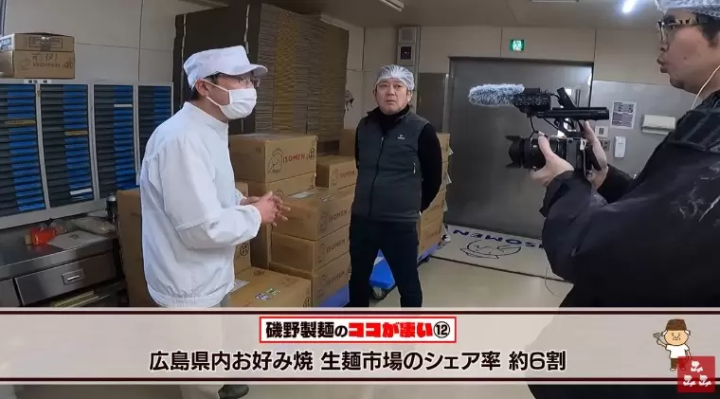Special noodles for okonomiyaki! What is the "Isono Noodle" that is indispensable at "Micchan Souhonten"?

When it comes to Hiroshima-style okonomiyaki, it's definitely the noodles that are essential! At "Micchan Souhonten," they use "Isono Noodles," fresh noodles made especially for okonomiyaki. They are made by "Isono Seimen Co., Ltd.", which has gained tremendous support from Hiroshima okonomiyaki restaurants. This time, we got a close look at the manufacturing process of Isono Noodles with "Second Generation Iune Mitsuo"! He told us about the particular manufacturing method.
What is Isono Seimen? We manufacture fresh noodles specifically for Hiroshima-style okonomiyaki!

*This article is an excerpt from the YouTube channel of "Hiroshima Okonomiyaki Mitchan Sohonten [Official]".
Isono Seimen Co., Ltd. was founded in 1962 as a noodle company that produces noodles specifically for Hiroshima's okonomiyaki. The first president, who was originally a rice milling company, began making fresh noodles specifically for okonomiyaki after being asked by the food stall owners he frequented if he could make noodles to put in okonomiyaki. The factory is open all year round, and produces 14,000 servings of noodles every day.
Apparently, there are four processes involved in making iso noodles: mixing, combining, rolling, and cutting. From here, let's take a look at how the noodles are made.
Noodle making process 1: Mixing
Let's start with the first process, "mixing."

Mixing refers to the process of combining flour, kansui, and water. This process is very important, and it is no exaggeration to say that the taste is determined by this process.

The wheat flour used is made specially for Isono Seimen. Since it is made specifically for okonomiyaki, they use an original blend of wheat flour that is resistant to the heat of the iron plate!

The kansui used is a secret recipe that has been handed down since the company was founded.

The wheat flour is mixed with kansui water. With expert craftsmanship, the amount of water is fine-tuned depending on the weather and humidity each day.
Noodle making process ② Complex
Next, let's take a look at the "composite" process of making noodles.

Combining is the process of stretching the mixed dough and applying pressure to it to form a protein called "gluten." Gluten consists of two types of proteins: "glutenin," which creates elasticity, and "gliadin," which creates the stretchiness of the noodles. The combination of these two proteins forms gluten, which gives the noodles their unique firmness.

Some of the craftsmen at Isono Seimen have been making noodles for over 60 years. The taste of Isono noodles has been preserved for so many years thanks to the skilled techniques of these craftsmen.
Noodle making process 3: Rolling
Next, let's look at the third process, "rolling."

Rolling is the process of passing the composite noodles between rollers to form them into a specific thickness.

At Isono Seimen, the noodles are rolled three times. This allows the gluten to develop further, resulting in noodles with texture and firmness. The noodles gradually become thinner, eventually reaching a thickness of about 5 mm.

"The firmness of the noodles is important to ensure that okonomiyaki tastes delicious down to the last bite," says Iune.
Noodle making process 4: Cutting
Finally, the last step is cutting out the wood.

Cutting is the process of cutting the rolled noodles.

There are noodles with round and square cross sections, but Isono Seimen uses noodles with a square cross section. Square noodles have a larger cross section, so they brown better when making okonomiyaki and also absorb the sauce better.

The cut noodles are then packed into bags and the dish is complete.
Okonomiyaki noodles are completed and shipped
Finally, let's take a look at the shipping process for the finished noodles.

The finished noodles are not shipped immediately because they contain a lot of moisture, but are left to rest in a temperature-controlled place for a day before being shipped the next day. This allows the noodles to mature and improve their flavor.

The newly cooked noodles are still hot, so holes are poked in the bag to allow the heat to escape.

About 500 items are shipped nationwide, with about half of them being sent outside the prefecture. Among them, some are sent to "Micchan Sohonten Tokyo Solamachi Store"!

Isono Seimen's noodles are used in restaurants all over the country, from Hokkaido in the north to Okinawa in the south. Of the 400 or so okonomiyaki restaurants in Hiroshima, about 250 use Gaiso's noodles! That's a market share of about 60%. That means that more than half of the okonomiyaki restaurants in Hiroshima Prefecture use Gaiso's noodles.
Marumen: Okonomiyaki specializing in soba noodles

At Marumen, an okonomiyaki restaurant on the second floor of Isono Seimen, you can eat okonomiyaki that specializes in soba noodles. In fact, the owner, Mr. Isono, was a classmate of Mr. Iune in junior high school. Marumen uses soba noodles from Isono Seimen and serves okonomiyaki that makes the most of their flavor. You can even see inside the noodle factory from inside the restaurant!
The key to the deliciousness of Micchan's okonomiyaki is the noodles!
This time, we introduced the secret behind the noodles that are essential to Mitchan Souhonten's okonomiyaki. The noodles are made with a number of steps and care. When you order okonomiyaki at Mitchan Souhonten, be sure to pay attention to the noodles as well.
Founded in Showa, the original Hiroshima-style okonomiyaki is made with the utmost care by Inune Mitsuo. "Mitchan," or Iune Mitsuo, is particular about "light and timeless okonomiyaki that you can eat every day." Without changing their traditional style, they continue to preserve the original Hiroshima-style okonomiyaki flavor.
The contents on this page may partially contain automatic translation.



























![[2026 Edition] FORMUAL 1 JAPANESE GRAND PRIX Information](https://resources.matcha-jp.com/resize/720x2000/2025/10/05-245984.webp)


![[2025 Update] Namba's spectacular illuminations! "Namba Hikari Tabi" with approximately 1 million shining lights](https://resources.matcha-jp.com/resize/720x2000/2025/12/12-252825.webp)